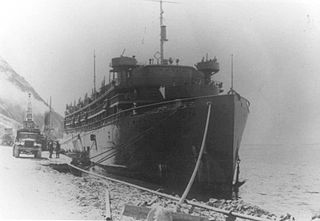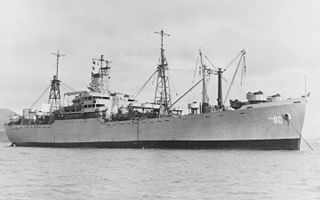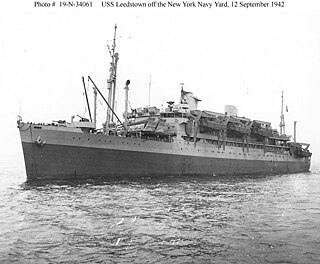
Dorchester was a coastal passenger steamship requisitioned and operated by the War Shipping Administration (WSA) in January 1942 for wartime use as a troop ship allocated to United States Army requirements. The ship was operated for WSA by its agent Atlantic, Gulf & West Indies Steamship Lines (Agwilines). The ship was in convoy SG 19 from New York to Greenland transiting the Labrador Sea when it was torpedoed by a German U-boat on February 3, 1943. The ship sank with loss of 674 of the 904 on board with one of the 230 survivors lost after rescue. The story of four Army chaplains, known as the "Four Chaplains" or the "Immortal Chaplains," who all gave away their life jackets to save others before they died, gained fame and led to many memorials.

USS Charger (CVE-30) was an escort carrier of the United States Navy during World War II converted from a commercial C3-P&C cargo/passenger liner hull built as Rio de la Plata intended for the Moore-McCormack company's American Republics Line serving the east coast of South America. The ship was requisitioned for conversion to an escort carrier type intended for Royal Navy use and initially commissioned as HMS Charger (D27). Days later the transfer was rescinded with the ship returning to U.S. Navy control to become USS Charger which operated throughout the war as a training ship on the Chesapeake Bay with two ferry missions to Bermuda and Guantánamo Bay, Cuba.

Type C2 ships were designed by the United States Maritime Commission (MARCOM) in 1937–38. They were all-purpose cargo ships with five holds, and U.S. shipyards built 328 of them from 1939 to 1945. Compared to ships built before 1939, the C2s were remarkable for their speed and fuel economy. Their design speed was 15.5 knots (28.7 km/h), but some could make 19 knots (35 km/h) on occasion. The first C2s were 459 feet (140 m) long, 63 feet (19 m) broad, and 40 feet (12 m) deep, with a 25-foot (8 m) draft. Later ships varied somewhat in size. Some, intended for specific trade routes, were built with significant modifications in length and capacity.

SS Manhattan was a 24,189 GRT luxury ocean liner of the United States Lines, named after the Manhattan borough of New York City. On 15 June 1941 she was commissioned as USS Wakefield and became the largest ship ever operated by the US Coast Guard. In 1942 she caught fire and was rebuilt as a troop ship. Manhattan never saw commercial service again.

USS Algorab (AKA-8) was laid down as Mormacwren, one of the earliest Maritime Commission-type C2 ships, on 10 August 1938 by the Sun Shipbuilding & Drydock Co., Chester, Pennsylvania as hull 177 for Moore-McCormack. Mormacwren was acquired by the United States Navy 6 June 1941, commissioned 15 June 1941 as USS Algorab (AK-25) and was redesignated an attack transport on 1 February 1943 with the hull number chanted to AKA-8. Algorab decommissioned on 3 December 1945 and was delivered to the Maritime Commission on 30 June 1946 for disposal, purchased by Wallem & Co. on 4 April 1947 for commercial service.

USS Mizar (AF-12) was the United Fruit Company fruit, mail and passenger liner Quirigua that served as a United States Navy Mizar-class stores ship in World War II.

USS Talamanca (AF-15) was the United Fruit Company cargo and passenger liner Talamanca that served as a United States Navy Mizar-class stores ship in World War II.

USS Tarazed (AF-13) was the United Fruit Company cargo and passenger liner Chiriqui that was acquired by the United States Navy through a sub bareboat charter from the War Shipping Administration (WSA) which acquired the ship by bareboat charter from the company. The ship served as a Mizar-class stores ship in World War II. In peacetime before and after the war she carried fruit and passengers; in war she supplied troops and ships in the field. In 1958 she was sold to a German shipping line and renamed Blexen which was scrapped in 1971 after 39 years' service.

USS Merak (AF-21), the second Navy ship of the name, was the United Fruit Company cargo and passenger liner Veragua that served as a United States Navy Mizar-class stores ship in World War II.

USS Kailua (IX-71) was originally CS Dickenson, a civilian supply and personnel transport cable-repair ship of the Commercial Pacific Cable Company that was based in Honolulu serving the island cable stations at Midway and Fanning Island.

USS Leedstown (AP-73), built as the Grace Line passenger and cargo ocean liner SS Santa Lucia, served as a United States Navy amphibious assault ship in World War II. The ship had first been turned over to the War Shipping Administration (WSA) and operated by Grace Line as the WSA agent from February to August 1942 in the Pacific. In August the ship, at New York, was turned over to the Navy under sub-bareboat charter from WSA. She was sunk 9 November 1942 off the Algerian coast by a German submarine after German bombers caused damage the day before.

USS William Ward Burrows was a transport ship that saw service with the United States Navy in World War II. The ship was the former Grace Steamship Company liner MV Santa Rita by Burmeister & Wain and launched in 1929 at Copenhagen, Denmark.

SS Maui was built as a commercial passenger ship in 1916 for the Matson Navigation Company of San Francisco and served between the United States West Coast and Hawaii until acquired for World War I service by the United States Navy on 6 March 1918. The ship was commissioned USS Maui (ID-1514) serving as a troop transport from 1918 to 1919. The ship was returned to Matson for commercial service September 1919 and continued in commercial service until purchased by the United States Army in December 1941. USAT Maui was laid up by the Army in 1946 and scrapped in 1948.

SS Antigua was a United Fruit Company passenger and refrigerated cargo liner completed as one of six nearly identical vessels, three built by Newport News Shipbuilding and three by Bethlehem Shipbuilding Corporation, for operation by the company's subsidiary the United Mail Steamship Company. The ship was the first of the ships built by Bethlehem Shipbuilding Corporation, Quincy, Massachusetts.
SS Haiti was a passenger and freight ship built for the Colombian Mail Steamship Company built at Newport News Shipbuilding, Newport News, Virginia and delivered 15 December 1932. The ship was renamed briefly Puerto Rico in 1938 and Monterey in 1939 to operate for the New York and Cuba Mail Steamship Company until requisitioned with transfer of title to the War Shipping Administration (WSA) on 25 September 1942. The ship was then allocated to the U.S. Army for operation under a bareboat agreement as USAT Monterey. In 1943 the ship was assigned to the command at Trinidad to supply bases in Brazil and Ascension Island. After layup in the reserve fleet the ship was sold to Turkey.

Corvus was a steam cargo ship built in 1919 by Columbia River Shipbuilding Company of Portland for the United States Shipping Board as part of the wartime shipbuilding program of the Emergency Fleet Corporation (EFC) to restore the nation's Merchant Marine. The freighter was operated on international and domestic routes through 1944. Early in 1945 she was transferred to Soviet Union as part of lend-lease program and renamed Uzbekistan. After several months of operation, the freighter was rammed by another vessel on 31 May 1945 and was beached to avoid sinking. She was subsequently raised and towed to Portland where she was scrapped in 1946.

Hawaiian Shipper was a 7,775 GRT Modified Type C3 cargo ship which was built in 1941 by Federal Shipbuilding and Drydock Company, Kearny, New Jersey for the United States War Shipping Administration. She was transferred to the Ministry of War Transport (MoWT) and renamed Empire Fulmar. She was transferred to the United States Maritime Commission (USMC) in 1942 and renamed Hawaiian Shipper. Converted in 1943 to a troopship for the United States Navy. To the USMC in 1946 and renamed America Transport. Sold in 1958 to the States Steamship Company and renamed Washington. Renamed Michigan and sold to the United States Maritime Administration in 1960. She was sold to the Waterman Steamship Corporation in 1969 and renamed Morning Light, she was scrapped in 1973 at Kaohsiung, Taiwan.
SS John Cadwalader was a coastal passenger and cargo steamer launched in March 1926 by Pusey & Jones Corporation, Wilmington, Delaware for the Baltimore-Philadelphia Steamship Company for operation on overnight service between Baltimore and Philadelphia. The intended route used the Chesapeake and Delaware Canal for an inland passage using Chesapeake Bay, Delaware Bay and the Delaware River.
Milwaukee Bridge was a steam cargo ship built in 1918–1919 by Submarine Boat Company of Newark for the United States Shipping Board (USSB) as part of the wartime shipbuilding program of the Emergency Fleet Corporation (EFC) to restore the nation's Merchant Marine. The vessel was first briefly employed on the East Coast to United Kingdom route during the first two years of her career before being laid up at the end of 1921. In 1927 she was acquired by Matson Navigation Company to operate between California and Hawaii and renamed Malama. On New Year's day 1942 while en route to New Zealand under U.S. Army operation with cargo of military supplies she was discovered by Japanese merchant raiders and was scuttled by her crew to prevent capture.

Californian was an early American motor cargo ship which was built in 1921 in Chester, Pennsylvania for the American-Hawaiian Steamship Company. She was sold to the British Ministry of War Transport in 1940 and renamed Empire Kite, and renamed Empire Seal later that year. She was torpedoed and sunk in February 1942.


















